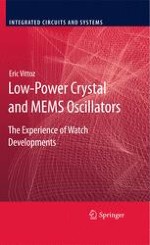2010 | Buch
Über dieses Buch
Electronic oscillators using an electromechanical device as a frequency reference are irreplaceable components of systems-on-chip for time-keeping, carrier frequency generation and digital clock generation. With their excellent frequency stability and very large quality factor Q, quartz crystal resonators have been the dominant solution for more than 70 years. But new possibilities are now offered by micro-electro-mechanical (MEM) resonators, that have a qualitatively identical equivalent electrical circuit.
Low-Power Crystal and MEMS Oscillators concentrates on the analysis and design of the most important schemes of integrated oscillator circuits. It explains how these circuits can be optimized by best exploiting the very high Q of the resonator to achieve the minimum power consumption compatible with the requirements on frequency stability and phase noise. The author has 40 years of experience in designing very low-power, high-performance quartz oscillators for watches and other battery operated systems and has accumulated most of the material during this period. Some additional original material related to phase noise has been added. The explanations are mainly supported by analytical developments, whereas computer simulation is limited to numerical examples. The main part is dedicated to the most important Pierce circuit, with a full design procedure illustrated by examples. Symmetrical circuits that became popular for modern telecommunication systems are analyzed in a last chapter.
Anzeige
